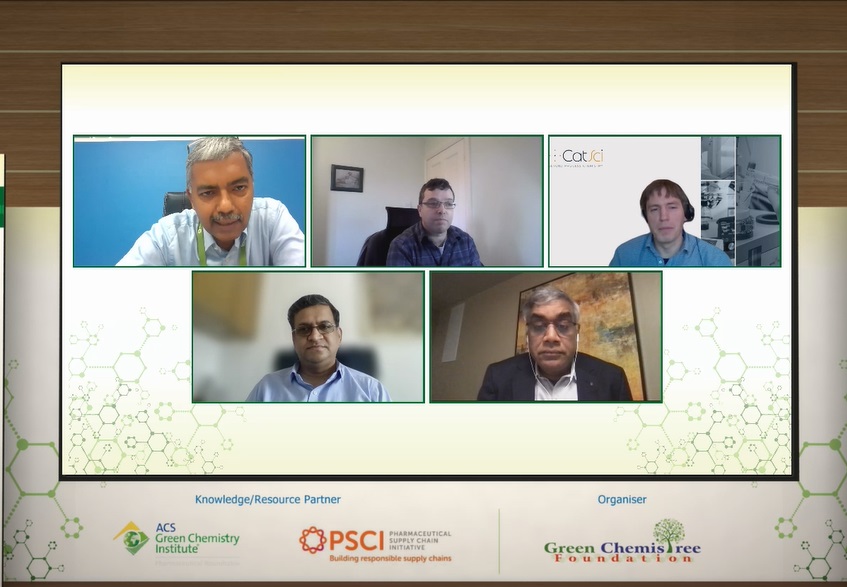"In biocatalytic processes, natural catalysts, such as enzymes, perform chemical transformations on organic compounds. Biocatalysis approach is much cleaner though you might need some purification. Electrocatalysis is the heterogeneous catalysis of electrochemical reactions where the electrode plays both the role of electron donor or acceptor and of catalyst. Engineering is important too as it helps the whole process to work," says Dr. Louis Dorazio, Senior Principal Scientist, New Modalities, Chemical Development, AstraZeneca.
Dr. Dorazio spoke at the panel discussion on 'Emerging Technologies that facilitate green chemistry' as a part of the virtual event, ‘Innovations in green and sustainable chemistry for the pharma industry’ organized by Green ChemisTree Foundation on 19-20 January, 2022. The discussion was moderated by Dr. Sudhir Nambiar, Chief Scientific Officer, Solara Active Pharma Sciences.
"The drug substance manufacturing includes solid phase synthesis that has 70 plus steps equal to solvent consumption which is as huge as 1,000s L/Kg. Purification processes such as chromatography have high purity water solvent consumption. Isolation generally has a freeze dry/solution method which produces high CO2. Molecules with large annual volumes with tens of kilos in weight are used quite often. Often these are optimized but the delivery of such large volumes is difficult. These molecules could have a heavy footprint. Solid phase is complicated and constricted and therefore, we could go for recombinant peptides and hybrid catalysis,” explains Dr. Dorazio.
Dr. Dorazio commented, “Nucleotides and peptides are smaller but we could easily scale up for tonnes of demand annually. Solution phase is easy. Purification would often start from a continuous approach for larger volumes and recoveries. In some cases we can apply continuous downstream processes. Avoiding frozen storage, minimizing energy supply and water treatment are required to get it back to the system. Small molecules are often ignored. Small contributions contribute to 40% of overall process mass intensity (PMI). Physical property and environmental footprint could be used for selection of solvents. With much shorter routes, better solvent recovery, green chemistry, we need to look at the situation holistically.”
As per Dr. Alan Stevan, Principal Scientist, CatSci, the carbon footprint of the solvent is very important for sustainability assessment which needs to be holistic.
“Making of membrane relies on solvent composition. The holistic approach is based on two types of criteria. One is based on molecular size and another is charged materials or ionic materials. Permeability might be different from non-charged material. Membrane separations in organic media as an emerging technology. Differences in concentration, pressure, or partial pressure make solvent and solute molecules want to move across membrane barriers. Actual flux is dictated by size of molecules and their interaction with membrane material. Being more energy efficient means of achieving concentration or a solvent swap than distillation. Better tools are needed to unpick complex interplay between solute, solvent and membrane to streamline membrane separation process design in organic media.” commented Dr. Alan Stevan.
Dr. Rakesh Ganorkar, Vice President, R&T, Hikal mentions, “Generally there are three ways of catalysis: organocatalysis, biocatalysis and metallic catalysis. We employ flow mode organocatalysis with solid support catalysis at our company. There are several examples where micro-reactors are being used for organocatalysis. Microwave radiation is another solution where sonication of the solution is used but it was found that chiral purity was eroding. We did the sonication study and found that an unwanted enantiomer was getting formed. We then tried some reactions using blue LEDs. We didn't get the desired product and we tried other options as well. Based on the lamp used, we got different reactions in the organocatalysis process. We have used green solvents such as trifluoromethyl. Ionic liquids are expensive but can be prepared in-house, and used for safe reaction. It is work in progress. Other solvents are glucose, malic acid and even water. Bran too is used as a substitute for a good reaction. All these catalysts along with flow chemistry could help in green chemistry.”
"Miscellaneous methods would be reactions under autoclave with higher pressure. Electrochemistry is another area that is interesting for organocatalysis which is both user and environment friendly. If we use principles of green chemistry to it, we will be able to make it more usable. We need some attention to details to make it possible. Selecting the appropriate solvent could help make the extraction become simpler. Looking at the process and principle is necessary while doing so," says Dr. Ganorkar.
“Green chemistry approaches to synthesis could make a big difference to pharma product outputs. Green chemistry catalysis could turn around things in a positive way. Generally after we design the synthesis route, we apply the catalysis process and wait for the outcome. In case the outcomes are not as desired, we can do modifications. While big companies don't have the time to go back due to large volumes and lack of time, mid-level generic companies making a large number of APIs could use electro-chemistry, bio-chemistry and gas phase processes. Ammoxidation catalysts are not used in the pharma industry whereas incorporating methyl chloride chlorination in the early stage of route design would help. Also if Chlorination, Fluorination and Oxidation are pursued through biocatalysis or electro catalysis. Apart from the new process innovations, it would be prudent for us to use the available talent at the academic institutes,” says Dr. Dhileep Krishnamurthy, Member of Scientific Advisory Board, TCG Green Chemistry, and Member, Advisory Board, Green Chemistry Journal.

